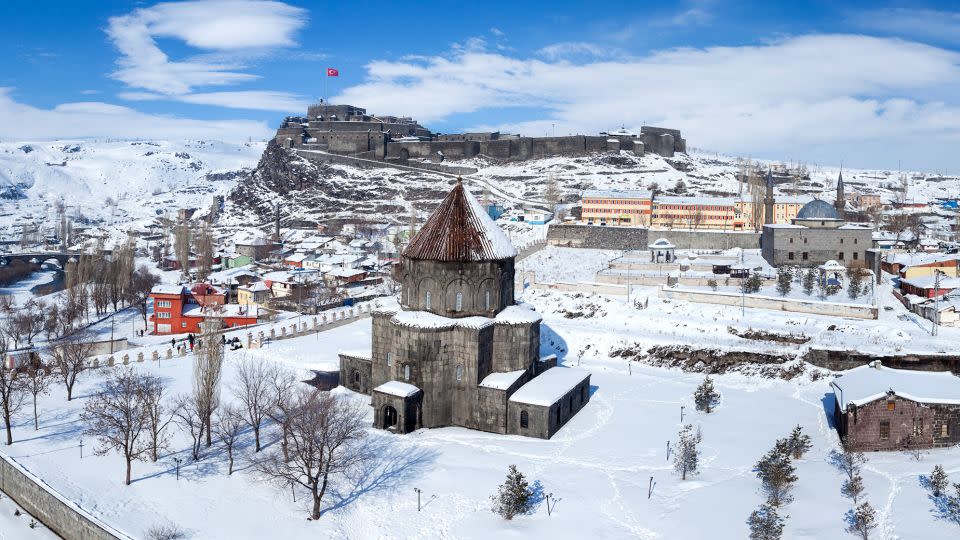The stunning 30-hour train ride that sells out in minutes
Editor’s Note: This CNN Travel series is, or was, sponsored by the country it highlights. CNN retains full editorial control over subject matter, reporting and frequency of the articles and videos within the sponsorship, in compliance with our policy.
Turkey is the final stop for one of the most famous train rides in the world, the Orient Express. But another journey – the Dogu Express, or Eastern Express in English – is making the country one of the world’s leading rail destinations.
Historically a commuter train from Ankara to Kars, the train has gone viral among Turkish influencers in recent years for its stunning scenery through the east, full of off-the-beaten-path treasures.
Berry Romo, a travel influencer who has been living in Turkey for over a decade, notes that “the train was already quite popular among locals and Turkish travelers, but barely known among foreign tourists.”
In response to the growing demand, the commuter service was, in 2019, turned into a tourist route. The 30-plus hours sleeper train runs from bustling capital Ankara to the sometimes snowy wonderland of Kars – a distance of 1,310 kilometers (814 miles) – with stops along the way where city excursions are organized.
However, tickets are notoriously hard to come by. Passengers say they often sell out within minutes.
“The trick is to check the website as soon as it’s midnight and buy when the website refreshes,” Romo said.
Turkish travel agencies usually buy large quantities of tickets to resell for tours they organize, ensuring their clients a place on the train, which is why, according to locals, tickets are gone so soon. Individual tickets can only be bought a month in advance, making them a coveted prize for the few who get them.

Leaving the capital
At first glance, Ankara might seem less glamorous than better-known Istanbul, but the political center of the country is a worthy destination in its own right.
Top sites include the Ataturk mausoleum, the final resting place of modern Turkey’s founding father, Mustafa Kemal Atatürk.
The complex is divided into four parts. Highlights include Peace Park, with a Turkish flag composed of pebble stones surrounded by a flower bed, and the Ceremonial Plaza which leads up to the Hall of Honor that houses the tomb of Ataturk.
Though Ankara embarked on a rapid pace of development after becoming the country’s new capital overnight in 1923, there is still some historical charm to be found among its old neighborhoods.
Ulus is the old quarter of the city where there are Roman ruins, preserved passageways and even an old castle, perched on a hill, offering sweeping panoramic vistas of the surrounding scenery.
Within Ulus lies Sanat Sokağı, or Arts Street, a stretch of restored Ottoman houses that have been converted into cafes leads to courtyards filled with stalls selling handicrafts and Ottoman-era souvenirs.
For a more contemporary experience, head to CemModern, a new art gallery hosting global exhibitions in a restored railway depot. The cultural events here are varied, ranging from movie screenings to group yoga sessions and design markets.

‘Stunning vastness’
The Dogu Express departs around early evening and, as it pulls away from the art deco Ankara railway station, the view out the window quickly morphs from sprawling metropolis to sweeping vistas.
Sleeper cabins are fitted with two single bunk beds that can be converted back down to seats during the day, a mini-fridge and a sink. Travelers often decorate their compartments with string lights, scarves and candles.
This makes for “a great way to enjoy a beautiful landscape in a cozy way,” according to Romo.
Early the next morning, the train arrives in Ilic, a small village whose main draw is its proximity to Karanalik, or Dark Canyon. The Canyon is home to the breathtaking Stone Road, which clings to the canyonside when it’s not plunging into one of its 38 tunnels or negotiating terrifying turns.

Despite a reputation for danger, the road regularly lures tourists with its stunning scenery. It offers dramatic cliffs and steep gorges, all with the Euphrates flowing below.
The train then descends further east, into the heartland of Anatolia. Netta Kalpan, a native Minnesotan who lived in the Black Sea coastal area of Trabzon and was used to harsh snowy winters, says she “didn’t realize how big, flat, and cold Turkey could be” before taking the train.
Yet, she describes the landscape as “stunning, mostly in its vastness.”
“I kept trying to take videos out the windows” but felt “like I wasn’t able to capture how it really felt to see it,” she says.

Final destination
As evening falls, the train pulls into Erzurum. Romo says visiting the city was “without a doubt, one of the best experiences” she’s had in Turkey for the city’s rich “history, culture, and extraordinary gastronomy.”
Erzurum is home to many different types of local cuisine, most famously, the Cag Kebab. Lamb is marinated for about 12 hours in onions, salt and pepper, then placed on a skewer and cooked over a wood fire before being wrapped in warm flatbread or eaten straight off the skewer.
After Erzurum, there are only a few hours left on the Dogu Express before it arrives at its final destination, Kars.
Famous for its winter wonderland landscape, its name is taken from the Turkish word for snow. The city is known for its unique architecture stemming from the days it was part of the Russian Empire.
Ummu Altunas, a lawyer from Istanbul, likens visiting the east of Turkey to visiting an entirely “different country” from the more European west. This is partly, she says, because “east is home to many different cultures,” such as Kurds, Armenians and Assyrians.
The medieval city of Ani, the former capital of the ancient Kingdom of Armenia, is one such example. Just a short drive from Kars, majestic ruins dating back 1,600 years are open to tourists. Vast walls and well-preserved churches, all overlooking a deep ravine, offer visitors a journey back through time.
Although Turkey’s eastern regions draw fewer tourists, locals are often eager to welcome visitors with traditional Turkish hospitality.
Kaplan says that one reason she loved living in the east of Turkey is because it was “gratifying to be around people who love where they’re from.”
She says she doesn’t mean to put down Istanbul, adding: “It’s easy to be proud of a place everyone agrees is one of the most magnificent cities in the world.”
But to embrace a place less frequented by travelers?
“That feels special.”
For more CNN news and newsletters create an account at CNN.com


